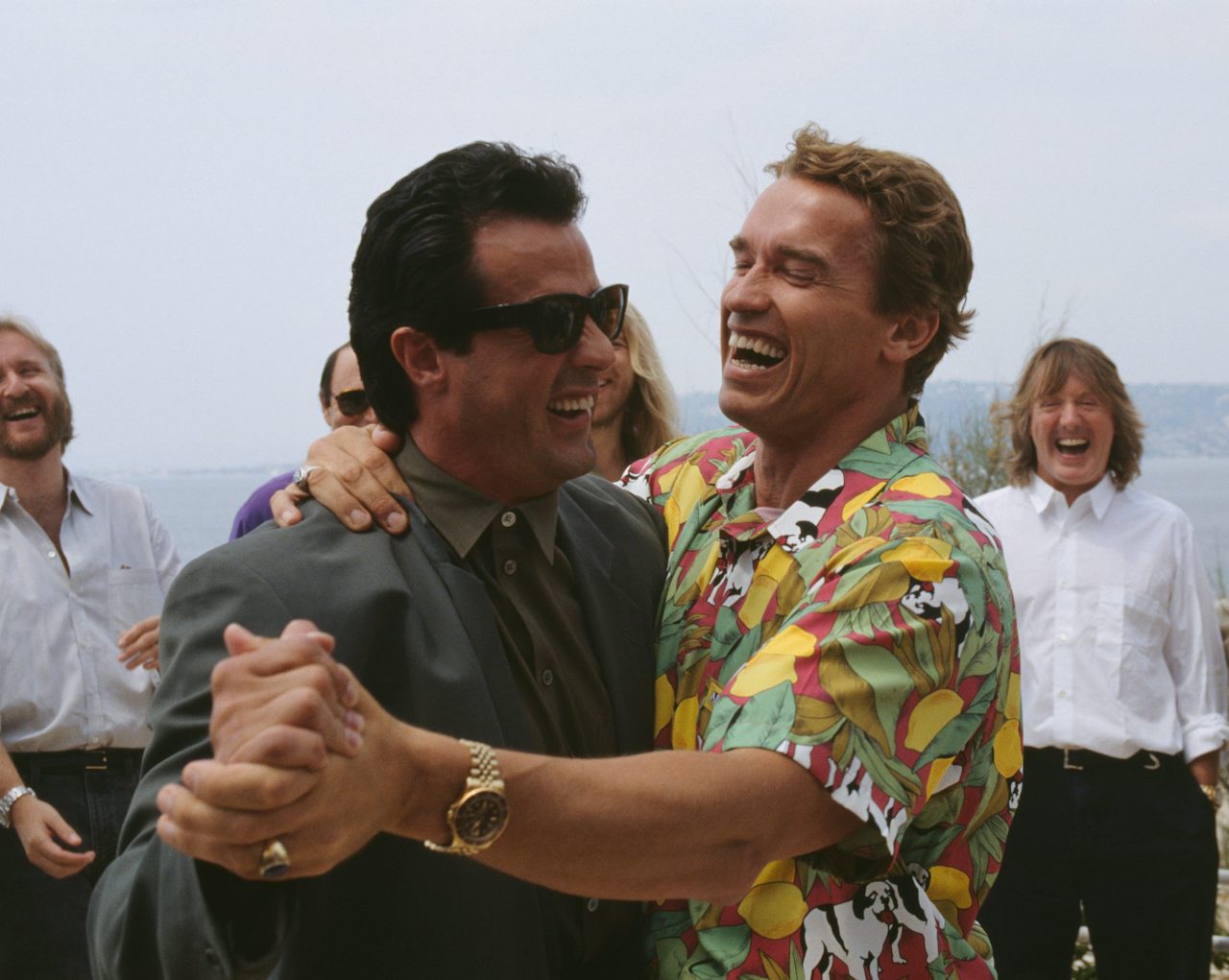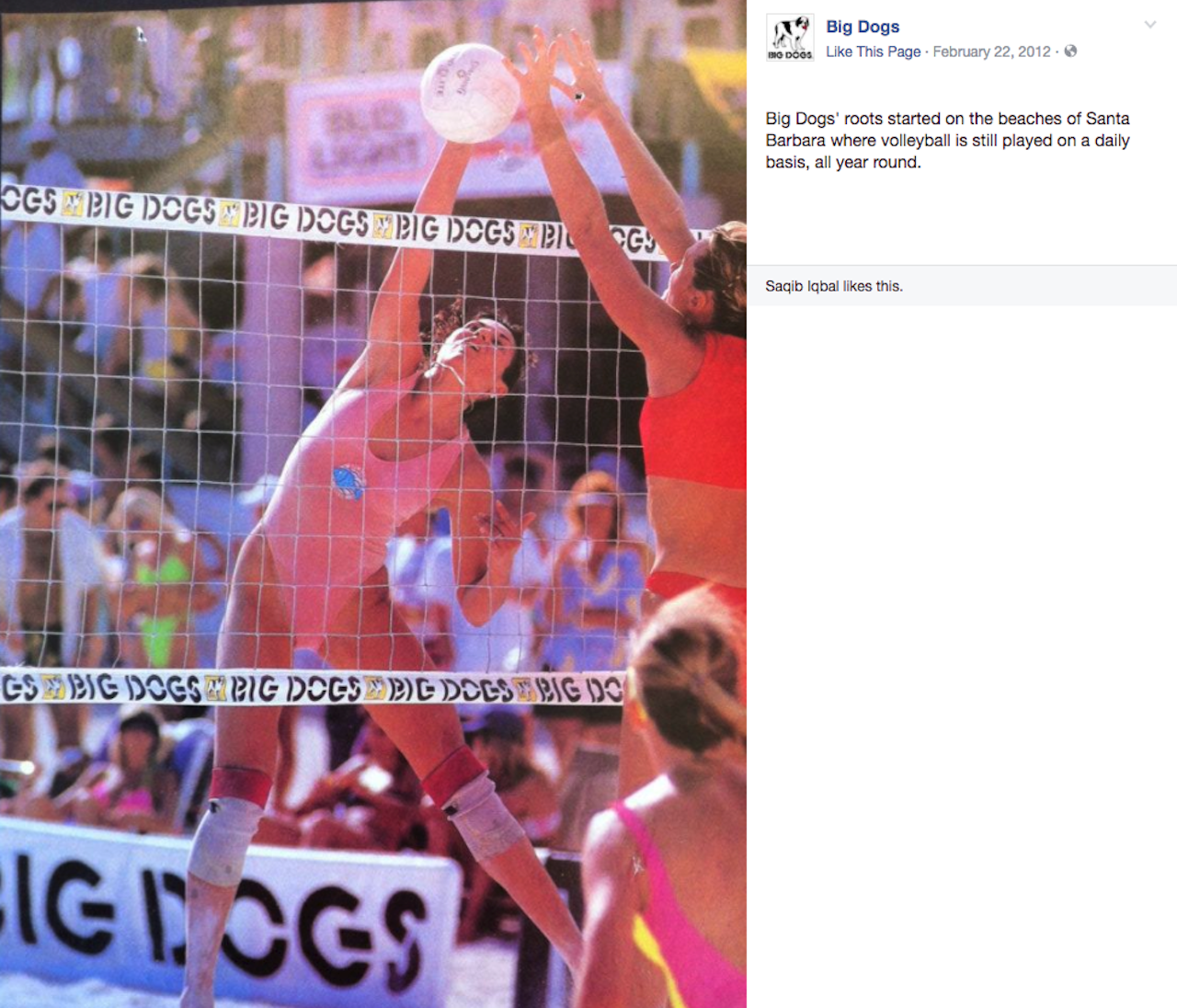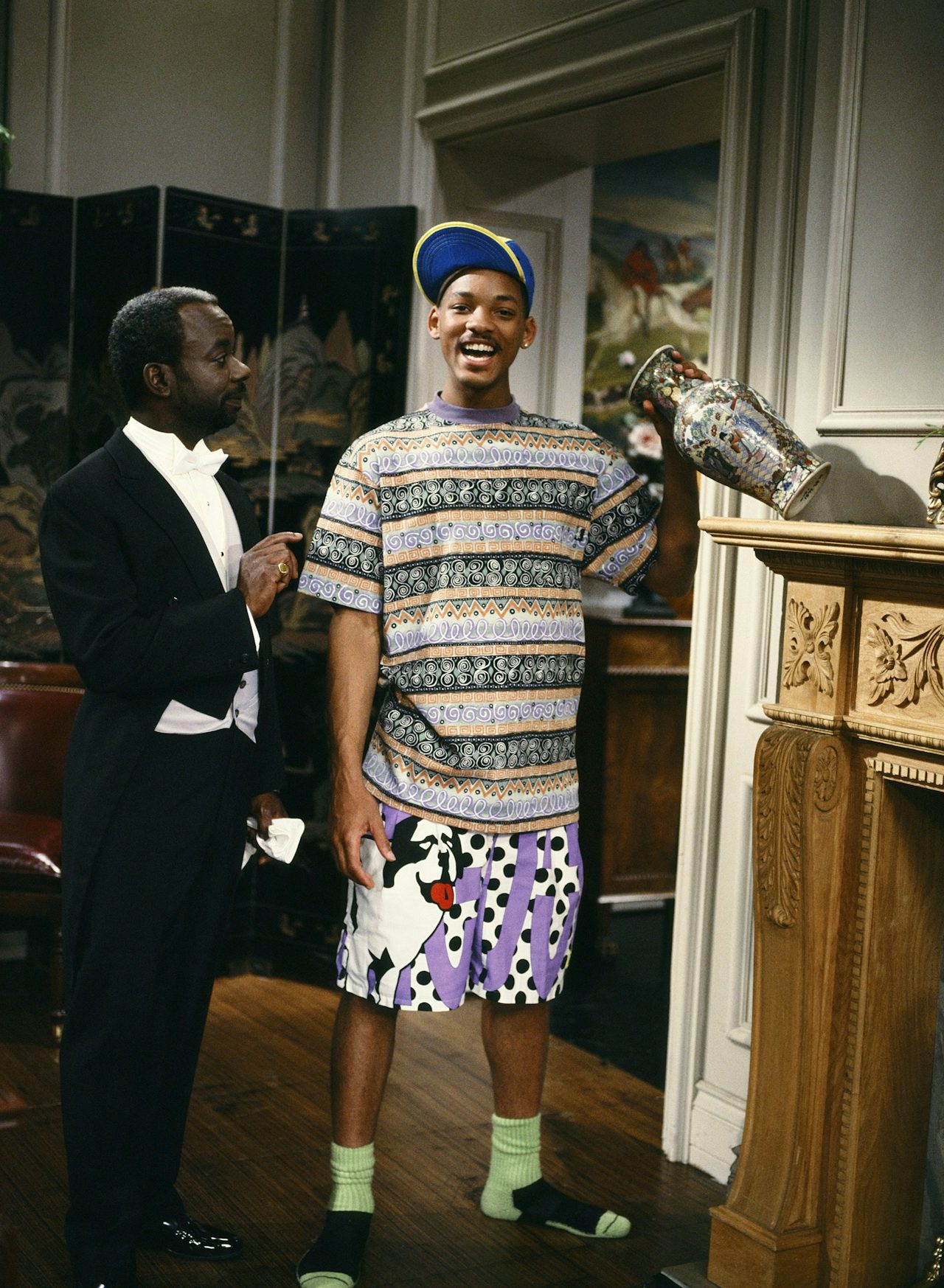You probably remember the Big Dog Sportswear catalog from the late ‘90s or early aughts. As a child, I flipped through it (along with the Oriental Trading Company catalog) when my parents would randomly decree that we’d watched too much TV. But I hadn’t thought about the brand in 15 or so years until someone (jokingly?) retweeted a sales announcement for 70-percent off a tee featuring a smirking Big Dog pointing at himself with a hand-paw-hybrid and the words “I’m In The BUTT KICKING BUSINESS AND BUSINESS IS GREAT” around him.
Initially I was stunned that Big Dog, like a phantasm from the past, was on Twitter, but then I realized the stranger thing is that the brand that celebrated most major cultural moments of my childhood, from the rise of Pokemon to Britney Spears’ “Oops...I Did It Again” video is still cranking out parody tees. In its heyday, Big Dog tees graced the torsos of Will Smith and Arnold Schwarzenegger; although the brand has lost some of its celebrity sheen, it has done its best to modernize. Their tees now showcase Big Dog’s take on politics (“Alternative Fact: I’ve Only Had One Beer…” one shirt says), his growing interest in fitness (“FIT’NESS WHOLE BURGER IN MY MOUTH!”), and distrust of dog-ified things like “Facebark.”
In recent years, the Big Dog brand has found cultural relevancy with the rise of Donald Trump; the New York media has derided the brand in kind. A 2015 Slate piece said Big Dog and its competitors, like Preakness and Coed Naked, made “douchebag shirts.” And an April piece on The Awl opened with the line “If you like dogs and toxic masculinity, you may be familiar with Big Dog Sportswear.” But while certain media outlets may speculate about the psyche of the white, working class American male, Big Dog Sportswear has been quietly cataloging his grievances for decades.
Twenty-three years ago, Steve Dawson joined Big Dog Sportswear as the manager of the brand’s sixty-sixth store. A lot has changed since then. The fan club has been disbanded; the standalone stores have closed (though, recently, seven have opened in vacation spots like Myrtle Beach, SC and Pigeon Forge, TN), and Big Dog doesn’t have the high-culture (or even ironically high-culture) weight it once did. Gone are the ‘90s neons and celebrity fans; in their absence, Big Dog Sportswear has honed in on what they do best — sarcastic, sometimes cruel, and often crude tees. “Through all this time, we’ve remained respectful of what the consumer that wants Big Dog and loves Big Dog and lives Big Dog expects,” Dawson, who is now the brand’s director, told me.
Here’s who that consumer is: male and middle-aged, he’s an “average-Joe,” “salt of the earth,” “very Middle America”-type guy, basically “anything from a farmer to a truck driver to a warehouse person,” Dawson said. For the Big Dog consumer, life isn’t always good, getting fed up is normal, and work probably isn’t very satisfying. Here’s what the Big Dog consumer likes: the line’s extensive sizing (which runs up to XXXXXXL), telling people off, dogs, lazing around, complaining about the wife.
Funnily enough, the brand’s simpler designs from the nineties — women’s high-cut one-pieces in neon colors with Big Dog's head peeking around the waist and bright shorts and tees — wouldn’t look out of place at Urban Outfitters today. But mostly, they’re working for the Big Dog Guy and it’s working. There’s a whole slew of occupational graphics, but jobs that “manifest a top-dog mentality” like police or military do particularly well. (It has been especially upsetting for the company that a fake Big Dog T-shirt illustration surfaced online with a big dog that very much resembles Big Dog in knock off Ray Bans sunglasses pointing his finger whilst surrounded by star spangled text that reads “Listen Here Bud..America Deserved 9/11.” Dawson said they’ve tried to get it removed, but that the graphic keeps re-appearing.)
To venture into the history of Big Dog, we must first consider the peculiar evolution of ‘90s fashion. One could say that the brand peaked in the ‘90s, with a 30,000-member strong fan club and more than 100 standalone stores; profits reached $115 million by 2000.
It was an era in which TV dads were decidedly not cool and real dads were even lamer and Big Dog, which first started churning out novelty tees in the early ‘80s, maintained something of a cool factor despite its persistent and unshakeable dad-ish-ness. I ask fashion historian Deirdre Clemente how, and why, this happened. “Big Dog was giving a big middle finger to traditional department stores,” Clemente told me. “At a time when the department store viewed itself as part-retailer part-educator and just kept trying to tell people what to do, Big Dog offered people a public means of expressing their individuality that today’s consumer takes for granted.” As local department stores were bought up and mergers proliferated through the ‘80s, the department store of the ‘90s suffered a “loss of retail diversity” and a “blander consumer experience,” according to From Main Street To The Mall: The Rise And Fall of The American Department Store.
The ‘90s consumer broke from tradition dictated by advertising and mass media by wanting to pick clothes for themselves. They wanted those clothes to say something about who they were, not just where they shopped. “United Colors of Benetton was doing something similar in celebrating ‘the other’ before we even used that term,” Clemente said. “But Big Dog’s other was decidedly anti-fashion, even when it was on trend. What they were saying was, ‘We are who we are and don't need to play by your rules.’” There were a few other factors that facilitated the success of Big Dog, namely what Clemente called a “rapid casualization of workplace and lifestyle” in the U.S. throughout the ‘90s, and the simultaneous expansion of sportswear from the court to the couch. Big Dog, perhaps the athleisure of its time, provided the perfect uniform for lounging.
The company that later created the character Big Dog began in 1971 as Sierra West. It was started by two childhood best friends — Richard Kelty and Rick Scott — looking for something to do after returning from Vietnam. Local stores were having trouble sourcing sleeping pads, so the pair promised to fulfill an order for 1,000 and taught themselves how to sew. By 1985, Sierra West was one of the top ten backpacking companies in the U.S., with an expanded range of products that included rain gear, tents, and other camping accessories. When I tracked Kelty down, he was at home at the base of the Sierra Mountains and not sure why I wanted to talk to him. I was searching for him because he was of those friends responsible for creating Big Dog back in the ‘80s. After a few awkward minutes on the phone, he acquiesced to being interviewed, saying “It’s your ball, I’ll roll with it,” and started talking.
Big Dog himself emerged by accident in 1983 or 1984. No one can quite remember. “Gib [Mann], one of our designers, came back from a trip on the Colorado River referring to everything large as a ‘big puppy.’ So when he saw the loose, soccer style shorts another employee had asked us to make, he said, ‘those are some big puppies,’” Kelty explained. “Gib tracked down a book on dogs and did a tracing, which we added to the shorts and poof, we were making Big Dogs.” Soon they added T-shirts and stuffed-animal puppies.
According to Kelty, people couldn’t get enough of Big Dog. One dealer came in to pick up his supply, grabbed a screen printed banner covered in Big Dogs and cut them into a pair of shorts. “He thought he was just the cat’s meow running around in those shorts,” Kelty said. The brand started manufacturing the patterned shorts, called Rad Dogs, and they too became a huge seller. “My son just called me a few weeks ago all excited because he’d bought a pair on eBay,” Kelty told me. Figures on Big Dog’s pre-acquisition success were not accessible.
Big Dog somewhat spontaneously came together, but also, Sierra West was looking for a way to diversify their offerings after Eddie Bauer, their biggest retailer, took production overseas. Big Dog was a big hit, but but not enough to save Sierra West. The company declared bankruptcy in 1990. With a specialty in buying bankrupt brands and turning them around, Andrew Feshbach and his partner Fred Kayne purchased Big Dog from within the larger camping company for $10 million in 1992. They brought the brand to outlet malls, which were the “hottest distribution channel” in the ‘90s, according to a blog post by David Meier, a portfolio manager at Motley Fool Funds, an investment firm known for its longstanding skepticism of Wall Street.
At a time when shoppers were turning away from department stores, as Deirdre Clemente explained, the outlet mall offered something of a judgement-free zone for shopping with Big Dog positioning itself as a purveyor of opinions and anger. Five years later, in 1997, the brand’s IPO raised $39.2 million; in just five years, they’d turned five stores into 134, from Maine to Hawaii. The brand peaked with 215 stores in 2001, but then, “strip malls anchored by big stores… started pulling people away from the outlet malls,” Meier said, and Big Dog’s revenues subsequently declined.
To an untrained eye, Big Dog’s tees haven’t changed all that much in the past few decades, but Big Dog has gotten more aggressive and new designs are being churned out at a rapid clip. They release ninety new T-shirts each year; there are more than 3,000 designs in the Big Dog archives. Steve Dawson and his small team, which includes three artists, meet at least once a week to toss around ideas, like they are the writing staff for a late-night show. During the Republican Debate in Detroit last year, when Trump said, “Look at these hands. Do these hands look like small hands?��� Dawson immediately knew they could Big Dog-ify it. A shirt with Big Dog in a tie that reads “Do These Paws Look Small?” was online within a business day. Dawson insists the shirt was apolitical. “It was nothing pro or negative,” Dawson said, “It was just, ‘Oh my gosh. That's crazy. Let's use that.’”
“I like to say that Big Dog was doing memes before memes were even invented,” Dawson said. Now, they try to stay abreast of internet culture. They considered riffing on the "Cash Me Outside" viral video when it blew up online last fall, but decided there wasn’t a good Big Dog take and that the meme probably wouldn’t have the kind of longevity that would make a consumer buy a tee.
“If it's offensive by its pure nature, it's not for Big Dogs,” Dawson told me. That said, a shirt that reads “I’d Unplug Your Life Support To Charge My Phone” is one of their top-selling graphics right now. (It was Dawson’s idea.) Kelty, who never worked with Dawson, is not convinced. “Their taste and design has gone downhill,” he said, “their acceptance of stuff that’s tacky amazes me.” It’s possible that Kelty is a tad jealous of losing a brand that went on to make so much money. Despite their differing taste, one thing is for certain: Big Dog buyers are mostly white. Dawson said Big Dog hasn’t done much consumer testing in the past few years, but from his own visits to stores and social media overseeing, he agreed with my racial assessment.
Dawson demurs when I ask him if there is such thing as a “Big Dog voter.’ He chafes at the recent characterization of the Big Dog Guy as reducible to a particular president, and even suggests that their politically minded T-shirts swing both ways. “Probably one of the two most popular political shirts we've done is one that's says ‘Democrat [], Republican [] Pissed Off []’ and the Pissed Off box is checked, because who's not?” Dawson said. The other most popular political shirt is one that says “When Did For The People By The People Become Screw The People?”
Over the span of a few months, Dawson and I chatted by phone and email as he traversed the country, between Big Dogs’ eight retail stores and his office in Santa Barbara. But in our initial wide-ranging, hour-long call, I nearly forgot to ask him what breed Big Dog is. “Obviously, he identifies mostly with Newfoundlands and St. Bernards,” Dawson said. “I believe that's where the inspiration for the logo came from. However, if you speak to a St. owner, they'll say the markings are not accurate and if you speak to a Newfie owner, they’ll remind you that most Newfoundlands are all black. Really, he’s not a specific breed, he’s an attitude."



